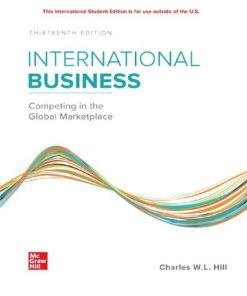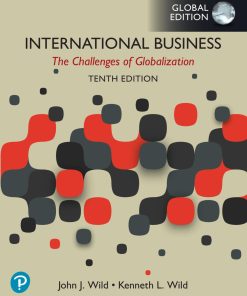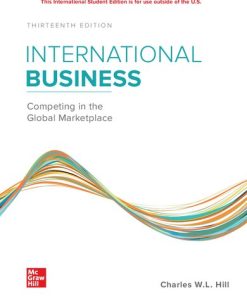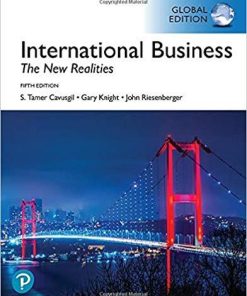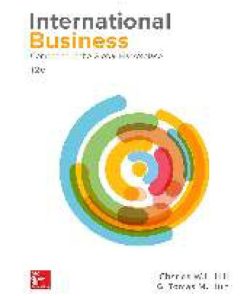(Ebook PDF) Global Business Analysis Understanding the Role of Systemic Risk in International Business 1st edition by Colin Turner 9798214346373 full chapters
$50.00 Original price was: $50.00.$25.00Current price is: $25.00.
Global Business Analysis: Understanding the Role of Systemic Risk in International Business 1st edition by Colin Turner – Ebook PDF Instant Download/DeliveryISBN: 9798214346373
Full dowload Global Business Analysis: Understanding the Role of Systemic Risk in International Business 1st edition after payment.
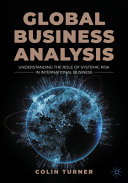
Product details:
ISBN-13 : 9798214346373
Author: Colin Turner
Understanding today’s rapidly changing global business environment can be challenging, particularly with conflicting news about how business actions in the European Union or emerging economies of Asia, or migrations from Mexico and Central America are impacting the U.S. and world economies. INTRODUCTION TO GLOBAL BUSINESS: UNDERSTANDING THE INTERNATIONAL ENVIRONMENT & GLOBAL BUSINESS, 3E provides a clear, comprehensive analysis of today’s global business environment, supported by current examples and mini-cases. Written by authoritative professionals, this edition introduces globalization using unparalleled scholarship and the fundamentals of the global business environment — culture, ethics, economics and information technology. You see how shifts in the global geopolitical balance of power and changing regional strategic alliances can impact job opportunities and future living standards, as the text flows from concept to application.
Global Business Analysis: Understanding the Role of Systemic Risk in International Business 1st Table of contents:
Part 1. Foundations of Global Business
1. The Rise of Globalization
1-1. What Is Globalization?
1-1a. Emerging Economies
1-1b. Decoupling and the Move to a Multipolar World Economic Order
1-2. Key International Institutions That Facilitate Globalization
1-2a. The International Monetary Fund
1-2b. The World Bank
1-2c. The World Trade Organization
1-3. Institutional Structure and Its Impact on Globalization
1-3a. What Is Institutional Structure?
1-3b. Transparency of Political Institutions
1-3c. Adaptive Institutions to Strengthen Public Participation
1-3d. Independent Judiciary and Free Press
1-4. Effective Policy Measures That Promote Globalization
1-4a. Good Governance
1-4b. Competitive Markets
1-4c. Property Rights
1-4d. Anticorruption Policies
1-5. Impact of Information Technology on Globalization
1-5a. The Digital Generation
1-5b. Expanding the Global Use of Information Technology
1-5c. The Digital Divide Myth
1-5d. How Countries “Leapfrog” into the Internet and Cell-Phone Era
1-6. The Globalization Controversy
1-6a. Job Losses and Income Stagnation
1-6b. Sustainable Development and Environmental Degradation
1-7. Making Globalization Work for All
1-7a. Globalization’s Winners and Losers
1-7b. Globalization’s Losers Need Support
Summary
Key Terms
Chapter Questions
Interpreting Global Business News
Portfolio Projects
2. The Evolution of International Business
2-1. Benefits of Trade and Foreign Direct Investment
2-2. Major Theories of International Trade
2-2a. Wealth Accumulation as a Basis for Trade Theory: Mercantilism
2-2b. Specialization as a Basis for Trade Theory: Absolute and Comparative Advantage
2-2c. Factor Endowments as a Basis for Trade Theory: Heckscher–Ohlin and Factor Price Equalization
2-2d. Porter’s “Diamond” Model of National Competitive Advantage
2-3. The Practice of Trade Policy
2-3a. Tariffs, Preferential Duties, and Most Favored Nation Status
2-3b. Nontariff Barriers
2-4. Current Practice of “Managed” Trade
2-4a. Socioeconomic Rationale
2-4b. Geopolitical Rationale
Summary
Key Terms
Chapter Questions
Interpreting Global Business News
Portfolio Projects
3. Regional Economic Integration
3-1. What Is Regional Economic Integration?
3-1a. Stages of Regional Integration
3-1b. Pros and Cons of Regional Integration
3-2. The Economic Geography of Regional Integration
3-2a. Steps to Regional Integration
3-2b. Major Classes and Characteristics of Regional Integration
3-3. Does Regional Integration Confound Global Trade?
3-4. The European Union
3-4a. Turkey
3-4b. The Euro
3-5. The United States-Mexico-Canada Agreement
3-6. The Association of Southeast Asian Nations
3-6a. ASEAN Security Community
3-6b. ASEAN Economic Community
3-6c. ASEAN Sociocultural Community
3-6d. The Future of ASEAN
3-7. Regional Integration in Latin America
Summary
Key Terms
Chapter Questions
Interpreting Global Business News
Portfolio Projects
4. The International Flow of Funds and Exchange Rates
4-1. The Balance of International Payments
4-1a. The Current Account
4-1b. The Capital Account
4-1c. The Financial Account
4-1d. Net Errors and Omissions
4-1e. Reserves
4-1f. World Trade and the Balance of Payments
4-2. The Foreign Exchange Market
4-2a. The Exchange Rate
4-2b. Components of the Foreign Exchange Market
4-3. International Monetary Systems
4-3a. Money and Inflation
4-3b. The Bretton Woods System
4-3c. The Flexible Exchange Rate System
4-3d. The Eurozone Euro
4-3e. Hard and Soft Currencies
4-4. International Flows of Goods and Capital
4-4a. Purchasing Power Parity
4-4b. Interest Rate Parity
4-5. Forecasting Exchange Rates
Summary
Key Terms
Chapter Questions
Interpreting Global Business News
Portfolio Projects
Part 2. Global Business Environment
5. The Cultural Environment
5-1. Defining Culture and Its Influence on Business
5-2. Elements of Culture
5-2a. Language
5-2b. Religion
5-2c. Values and Attitudes
5-2d. Manners and Customs
5-2e. Material Elements
5-2f. Aesthetics
5-2g. Education
5-2h. Social Institutions
5-3. Clustering Countries and Regions by Culture
5-3a. Hofstede’s Research
5-3b. Trompenaars’s Cultural Dimensions
5-3c. The GLOBE Project
5-3d. Gannon’s Cultural Metaphors
5-4. Sources of Cultural Information
5-5. Cultural Dimensions of Conducting Business in Individual Countries
5-5a. Cultural Dimensions of Doing Business in Japan
5-5b. Cultural Dimensions of Doing Business in Korea
5-5c. Cultural Dimensions of Doing Business in China
5-5d. Cultural Dimensions of Doing Business in Arab Countries
5-5e. Cultural Dimensions of Doing Business in Latin America
5-5f. Cultural Dimensions of Doing Business in India
5-5g. Cultural Dimensions of Doing Business in Russia
5-5h. Cultural Dimensions of Doing Business in South Africa
5-6. The Importance of Culture for Managing and Marketing in Overseas Markets
5-6a. Management Styles
5-6b. Product Development and Management
5-6c. Advertising Campaigns
5-6d. Communication
Summary
Key Terms
Chapter Questions
Interpreting Global Business News
Portfolio Projects
6. The Legal and Political Environment of Global Business
6-1. Political Systems
6-2. National Economic Ideologies
6-2a. Communism
6-2b. Socialism
6-2c. Capitalism
6-3. Political Risks, Economic Risks, and Corruption
6-3a. Economic Risks
6-3b. Political Risks
6-3c. Corruption
6-3d. Public Corruption
6-4. The Legal Environment
6-4a. Legal Systems
6-4b. Criminal Law
6-4c. Contract Law
6-4d. Tax Law
6-4e. Antitrust Law
6-4f. Product Safety Law
6-4g. Dispute Settlement Law
6-5. Intellectual Property Protections
6-5a. Patents
6-5b. Trademarks
6-5c. Copyrights
Summary
Key Terms
Chapter Questions
Interpreting Global Business News
Portfolio Projects
7. Corruption and Ethics in Global Business
7-1. What Is Ethics?
7-2. Ethics in Business and Society
7-2a. Ethics and Economics
7-2b. The Corruption Perceptions Index and Transparency International
7-3. What Is Corporate Social Responsibility?
7-3a. Rules, Policies, and Guidelines
7-3b. Ethics Codes at Selected Companies
7-4. Financial Scandals
7-4a. Enron
7-4b. WorldCom
7-4c. Vivendi
7-4d. Parmalat
7-4e. Other Financial Scandals
7-5. Can Ethics Be Taught?
7-6. Internal Controls
7-6a. Foreign Corrupt Practices Act
7-6b. Computer Security of Accounting Information
Summary
Key Terms
Chapter Questions
Interpreting Global Business News
Portfolio Projects
Part 3. Global Business Strategy and Organization
8. Entry Strategies in Global Business
8-1. Strategy Choice and Implementation: Going International
8-1a. Export-Import Business
8-1b. Licensing
8-1c. Franchising
8-1d. Strategic Alliances
8-1e. International Joint Ventures
8-1f. Cross-Border Mergers and Acquisitions
8-1g. Wholly Owned Subsidiaries
8-2. Multinational Enterprises (MNEs)
8-3. MNEs and Their Global Strategic Motives
8-3a. Revenue Maximizing Strategies
8-3b. Cost-Minimizing Strategies
8-3c. Risk Minimizing Strategies
8-3d. Dunning’s Eclectic Theory of Foreign Direct Investment
8-4. Host Country Perspective of Foreign Direct Investment
8-4a. Benefits of Foreign Direct Investment
8-4b. Costs of Foreign Direct Investment
8-5. Improving Host Country’s Investment Climate
Summary
Key Terms
Chapter Questions
Interpreting Global Business News
Portfolio Projects
9. Control of Global Business
9-1. Strategy Formulation
9-1a. Mission Statement
9-1b. Shareholders versus Stakeholders
9-2. Strategy Implementation
9-2a. An Example of Strategic Implementation: Walmart Corporation
9-2b. Prospectors, Defenders, Reactors, and Analyzers
9-3. Coordination
9-3a. Impediments to Coordination
9-3b. Knowledge Management and Systems
9-4. Control Systems
9-4a. Bureaucratic Controls
9-4b. Interpersonal Controls
9-4c. Output Controls and Measurement
9-5. Organization Culture and the Change Control Function
9-5a. Types of Organizational Culture
9-5b. Organizational Change
Summary
Key Words
Chapter Questions
Interpreting Global Business News
Portfolio Projects
10. The Organization of Global Business
10-1. The Stateless Corporation
10-2. Organizing Global Business
10-3. Export Departments and International Divisions
10-3a. Creating an Export Department
10-3b. International Division
10-4. Four Organizational Structures for Global Business
10-4a. Functional Structure
10-4b. Divisional Structure
10-4c. Hybrid Structure
10-4d. Matrix Structure
Summary
Key Terms
Chapter Questions
Interpreting Global Business News
Portfolio
Part 4. Managing Global Business
11. Global Human Resource Management
11-1. Global Strategic Human Resource Management
11-1a. Statistical Overview
11-1b. Cultural Issues and Differences
11-1c. Regulatory Issues Including Immigration and Border Security
11-1d. Outsourcing and Offshoring
11-2. Staffing Policies
11-2a. Virtual Staffing
11-2b. Expatriate Issues in Staffing
11-2c. What Are Training and Development?
11-2d. Needs Assessment
11-2e. Types of Training and Development
11-2f. Expatriate Needs in Training and Development
11-3. Performance Appraisal and Compensation
11-3a. Assessing Performance
11-3b. Cultural Differences in Performance Appraisal
11-3c. Compensation and National Differences in Cost of Living
11-3d. Expatriate Issues in Compensation
11-3e. Executive Pay
11-4. International Trade, Labor Relations, and HRM
11-4a. The North American Agreement on Labor Cooperation and the USMCA
11-4b. International Labor Relations
11-4c. Comparative Labor Relations
Summary
Key Terms
Chapter Questions
Interpreting Global Business News
Portfolio Projects
12. Global Marketing
12-1. Marketing Research vs. Marketing Intelligence Systems
12-2. Making the Standardization and Adaptation Decision
12-3. Developing the International Product Mix
12-3a. Developing New Products for International Markets
12-3b. Managing Existing Products
12-3c. Where to Locate Research and Development Facilities
12-3d. Product Counterfeiting
12-4. Developing the International Promotion Mix
12-4a. Advertising
12-4b. Personal Selling
12-4c. Digital Marketing
12-4b. Sales Promotion
12-4e. Publicity
12-5. Developing the International Distribution Mix
12-5a. Channels of Distribution
12-5b. Physical Distribution
12-6. Developing the International Pricing Mix
12-6a. Pricing Objectives
12-6b. Setting Prices in International Markets
12-6C. Dumping
12-6D. Transfer Pricing
12-7. Developing the International Customer Service Mix
Summary
Key Terms
Chapter Questions
Interpreting Global Business News
Portfolio Projects
13. Global Operations and Supply-Chain Management
13-1. Global Operations Management
13-2. Global Procurement
13-2a. Advantages of Global Procurement
13-2b. Disadvantages of Global Procurement
13-2c. Outsourcing and Insourcing
13-3. Global Production
13-3a. Advantages of Making (In-House Manufacturing)
13-3b. Disadvantages of Making (In-House Manufacturing)
13-4. Location Decision
13-4a. Location of Production Facilities for Components and Raw Materials
13-4b. Location of Production Facilities for Final Products
13-4c. Relocation of Production Facilities
13-5. Global Supply-Chain Management
13-5a. Improving Global Supply-Chain Management
13-5b. The Role of Information Technologies
Summary
Key Terms
Chapter Questions
Interpreting Global Business News
Portfolio Projects
14. Global Financial Management
14-1. Measuring Foreign Exchange Exposure
14-2. Hedging Forex Risk with Derivatives
14-2a. Futures Contracts
14-2b. Forward Contracts
14-2c. Options Contracts
14-2d. Swap Contracts
14-3. Financing International Trade and Investment
14-3a. International Banking
14-3b. International Bond Markets
14-3c. International Stock Markets
14-3d. Government Financing
14-4. Multinational Capital Budgeting
14-4a. Parent Firm Capital Budgeting
14-4b. The Cost of Capital: Domestic versus Global
14-5. Currency Risk and Stock Valuation
14-5a. Cash Flow Sensitivity to Exchange Rate Risk
14-5b. Stock Values and Foreign Exchange Movements
Summary
Key Terms
Chapter Questions
Portfolio Projects
15. Accounting and Taxation in Global Business
15-1. Accounting and Financial Reporting in Global Business
15-1a. Management Accounting
15-1b. Financial Accounting
15-2. Generally Accepted Accounting Principles (GAAP)
15-2a. U.S. GAAP
15-2b. International GAAP
15-2c. Differences between U.S. and International GAAP
15-2d. Differences between U.S. GAAP and Selected Countries
15-3. International Financial Reporting Standards
15-4. The Role of Auditing and the Sarbanes-Oxley Act
15-5. Financial Statement Analysis
15-5a. Financial Ratios
15-5b. Evaluating Trends
15-6. Global Tax Matters
15-6a. Tax Rates among Selected Countries
15-6b. Transfer Pricing
People also search for Global Business Analysis: Understanding the Role of Systemic Risk in International Business 1st:
global business definition and examples
global business and marketing
global business analyst salary
global business and analytics complex
understanding international business
You may also like…
Business & Economics - Accounting
ISE International Business: Competing in the Global Marketplace 13th Edition Charles Hill
Business & Economics - Management & Leadership
Business & Economics
Business Analysis and Design: Understanding Innovation in Organisation 1st Edition
Politics & Philosophy - International Relations
Business & Economics - Markets
International Business: The Challenges of Globalization, Global Edition10th Edition
Business & Economics - Management & Leadership
International Business – Competing in the Global Marketplace 13th Edition
Business & Economics
International Business: Competing in the Global Marketplace 12th Edition




